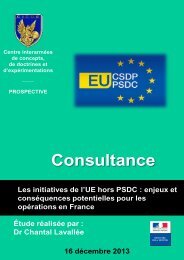Conference
science-research-bulletin-2013-conference
science-research-bulletin-2013-conference
You also want an ePaper? Increase the reach of your titles
YUMPU automatically turns print PDFs into web optimized ePapers that Google loves.
EUROPEAN POLICE SCIENCE AND RESEARCH BULLETIN<br />
SPECIAL CONFERENCE EDITION<br />
Much practitioner work has aimed at raising<br />
awareness of the opportunities presented to the<br />
police and emergency services by new platforms.<br />
There is a growing literature of experiential<br />
case studies by practitioners themselves —<br />
the Queensland experience in the floods of<br />
2011 (Queensland Police, 2010) or the Greater<br />
Manchester Police experience of using Twitter<br />
(GMP 2011) to raise public awareness of the<br />
range of their control room activities. Indeed,<br />
much of the efforts of organisations such as<br />
the College of Policing in the UK, or the IACP<br />
Center for Social Media in the US can be seen<br />
as a bringing together lessons learned from this<br />
practical experience.<br />
A comparative approach is taken in ‘Best<br />
Practice in Social Media Adoption’ by published<br />
by the Frauenhofer-Institute as part of the<br />
FP7 COMPOSITE programme (Denef 2012),<br />
comparing practice in 13 countries, using<br />
as data interviews with practitioners. Denef<br />
summarises the aims of this work and describes<br />
how COMPOSITE has identified the emergence<br />
of social media as a pressing issue for the police.<br />
The programme takes the view that social<br />
media can support the police in engaging in<br />
a closer dialogue with the public, support the<br />
identification of missing people and help large<br />
scale police operations in crises situations. Social<br />
media, however, also threaten the police, as<br />
offenders, for instance, increasingly use social<br />
media to coordinate their actions. Social media<br />
makes police actions transparent and challenges<br />
the ways in which the police operate.<br />
2. RESEARCH THEMES<br />
The need to understand how the police could<br />
best exploit social media was made more urgent<br />
by the experience its use by non-state actors in<br />
public order incidents such as the anticapitalist<br />
protests of 2010 and the UK riots of 2011, and<br />
by the debate about the role of social media as a<br />
tool for popular organisation in the early phases<br />
of the Arab Spring in 2011. But while, in the<br />
UK at least, there was political pressure to react<br />
and develop operational capability, variously<br />
articulated by Ministers and the regulatory body<br />
HM Inspectorate of Constabulary, there was less<br />
pressure for reflection on practice in order to<br />
understand whether more profound changes in<br />
police organisations and their relationship with<br />
the public which were being brought about by<br />
social media.<br />
There is a strong element of advocacy in the<br />
practitioner material. There has been the<br />
development of a community of social media<br />
users within police forces and organisations,<br />
which is highly committed to spreading what<br />
they see as an innovation of undoubted value to<br />
as many colleagues as possible. Indeed, one of<br />
the fundamental questions, which COMPOSITE<br />
addresses, is ‘how to explain the issue of nonadoption’.<br />
In parallel, the academic world to some extent,<br />
think tanks to a greater extent and the press<br />
most of all have developed a discourse about the<br />
changing nature of the policing task which has<br />
been brought about by the emergence of social<br />
media. This is manifested in three ways:<br />
The emergence of new forms of crime and<br />
antisocial behaviour — online pornography,<br />
bullying, verbal sexual abuse, new types of fraud;<br />
The opportunity afforded to law breakers to<br />
improve their own communications and so<br />
present new risks — rioters, terrorists most<br />
spectacularly;<br />
The development of new opportunities for<br />
the police to create and develop sources for<br />
intelligence, either in relation to the investigation<br />
of particular offences, covert investigation of<br />
groups and organisations, or the analysis of wider<br />
social trends as a basis for predictive policing.<br />
In this last case, social media has become one of<br />
a number of sources for big data analysis. The<br />
examples, which have been discussed, include<br />
big data correlations in relation to natural<br />
emergencies as much as to criminal or public<br />
order trends.<br />
Much of this debate has become focussed on<br />
issues of legitimacy and the safeguards for the<br />
public in respect of the enhanced capabilities<br />
of states to mount surveillance operations<br />
against social media usage. This is after all at<br />
the heart of the Edward Snowden case and the<br />
subsequent public debate about whether the<br />
US authorities have been complying with their<br />
own regulatory requirements or not (Greenwald<br />
2013). For social media more generally, the work<br />
which Jamie Bartlett has led at Demos (Bartlett<br />
et al. 2012), has identified the challenges which<br />
107





